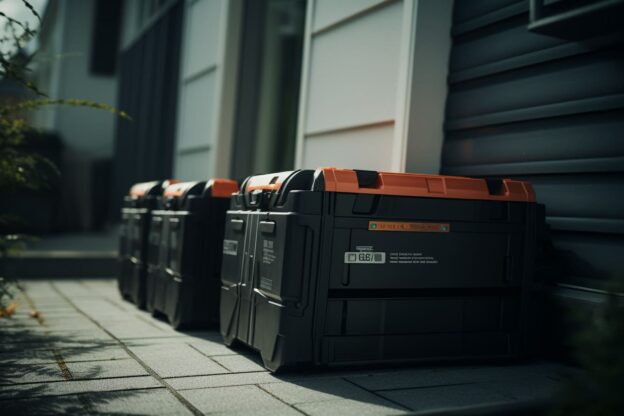Installing solar panels on your home is a great way to reduce your energy bills and carbon footprint. But what happens when the sun isn’t shining? That’s where solar batteries come in. Also known as solar energy storage systems, they allow you to store excess solar power generated during the day for use at night.
How Do Solar Batteries Work?
Solar panels produce DC power that gets converted into AC power for your home’s electrical system. When your panels produce more electricity than you need, the excess gets sent to the utility grid.
With a solar battery, that extra electricity gets stored instead. Batteries can be charged directly from solar panels or via the electrical grid. Then at night or during an outage, they discharge power for your home. EnergySage provides a helpful overview of how solar batteries function.
Key Benefits of Adding Solar Battery Storage
- Reduce your reliance on the grid – With enough solar battery capacity, you may be able to disconnect from the grid entirely. This provides backup power during grid failures.
- Use more of the solar power you generate – Being connected to the grid limits how much of your own solar electricity you can use directly. Batteries let you store and use more of that solar energy.
- Potential savings on time-of-use rates – Storing lower-cost solar power in batteries during the day can reduce usage of higher-priced electricity in peak evening hours.
- Eligibility for solar tax credits and incentives – Adding a solar battery may qualify you for additional financial incentives. The DSIRE database lists available state and federal incentives.
What to Consider When Choosing a Solar Battery
- Battery capacity – Daily energy needs and budget will determine how much storage capacity you require. Many homeowners start with 5-10kWh systems.
- Battery chemistry – Lithium-ion batteries have become the dominant chemistry for home use given their performance and lifespan.
- Warranties and product certifications – Reputable manufacturers offer 10-year or longer warranties and UL certification.
- Monitoring capabilities – Many batteries include apps and software to monitor system performance and optimize operation.
- Installer expertise and support – A qualified local installer is key for proper siting, configuration, and follow-up maintenance. EnergySage outlines best practices for solar battery installation and maintenance.
Real-World Solar Battery Applications
- Grid independence – By storing solar energy in batteries, some homeowners have eliminated their electric bill and reliance on the grid entirely.
- Back-up power – Solar batteries can form a microgrid to provide power to critical home loads during grid outages. This is especially valuable for medical devices.
- Reducing peak demand charges – Businesses are adding solar batteries to cut peak energy consumption from the grid during costly daytime periods.
- Off-grid solar cabins – Batteries enable fully solar-powered homes in rural locations without utility grid access.
Solar Batteries Offer Self-Reliance and Energy Savings
With the falling costs of lithium-ion batteries, adding energy storage to your solar system is more viable than ever. Work with a qualified solar pro to properly size and install a solar battery that maximizes your energy independence and bill savings. Harness the sun’s power throughout the day and night with solar batteries.
